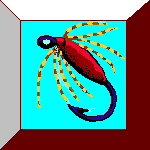INSECT STAGE
NymphAdult

NYMPH FAMILY KEY
1. Legs flanged for burrowing; mandibles bearing long tusks---------------------Ephemeridae 1. Legs cylindrical or flattened in cross-section; mandibles without long tusks---------------------2 2. Gills of abdominal segment 2 operculate, almost entirely covering remaining gills---------Caenidae 2. Gills of abdominal segment 2 absent or, if present, not operculate-----------------------3 3. No gills on segments 1-2 (in some cases, 1-3)----Ephemerellidae 3. Gills on segments 1-7 or 1-6---------------------4 4. Gills on segments 1-6 (largely concealed by carapacelike extension of mesonotum)-------------Baetiscidae 4. Gills on segments 1-7----------------------------5 5. Body strongly flattened; eyes on dorsal surface of head-------------------Heptageniidae 5. Body not strongly flattened----------------------6 6. Tails clothed with short hairs on both sides-----Leptophlebiidae 6. Outer pair of tails with hairs on inner (mesal) sides only-------------------------------7 7. Front tarsal claw double-------------------------Ametropidae 7. Front tarsal claw single-------------------------Baetidae
NYMPH GENERA KEY
EPHEMERIDAE
1. Frontal prominence of head deeply forked---------------------------Ephemera 1. Frontal prominence of head rounded---------------------------------HexageniaCAENIDAE
1. Operculate gills of abdominal segment 2 triangular-----------------Tricorythodes 1. Operculate gills not triangular------------------------------------2 2. Operculate gills with inner margins overlapping, outer margins rounded; head with prominent tubercules--------------Brachycercus 2. Operculate gills nearly rectangular, not overlapping at inner margins; head without tubercules--------------------------CaenisEPHEMERELLIDAE
This family contains but one common genus-----------------------------EphemerellaBAETISCIDAE
This family contains but one genus------------------------------------BaetiscaLEPTOPHLEBIIDAE
1. Gills of abdominal segment 1 deeply cleft, of segments 2-7 broad, platelike, with long apical extensions------------------Leptophlebia 1. Gills of abdominal segments 1-7 alike, deeply cleft----------------ParaleptophlebiaBAETIDAE
1. Gill tufts at base of maxillae and at foreleg bases---------------Isonychia 1. No gill tufts at base of maxillae or foreleg bases----------------2 2. Posterolateral angles of abdominal segments prolonged as thin, flat spines----------------------------------------------Siphlonurus 2. Posterolateral angles of abdominal segments not prolonged as spines-----------------------------------------------3 3. Gills single------------------------------------------------------4 3. Gills double or, if single, bearing a recurved flap---------------6 4. Hind wing pad absent----------------------------------------------Pseudocloen 4. Hind wing pad present---------------------------------------------5 5. Middle tail as long as outer tails--------------------------------Centroptilum 5. Middle tail shorter than outer tails------------------------------Baetis 6. Hind wing pad present---------------------------------------------Callibaetis 6. Hind wing pad absent----------------------------------------------CloenAMETROPIDAE
1. Maxillary palp two-segmented--------------------------------------Metretopus 1. Maxillary palp three-segmented------------------------------------SiphloplectonHEPTAGENIIDAE
1. Gills of abdominal segment 7 slender, fingerlike------------------Stenonema 1. Gills of all segments platelike-----------------------------------2 2. Gills of abdominal segments 1 and 7 enlarged, each pair converging beneath the abdomen to form, with other gills, an adhesive disk--------------------------------------------------Rithrogena 2. Gills in normal position, not modified as above-------------------3 3. Tails two---------------------------------------------------------Epeorus 3. Tails three-------------------------------------------------------Heptagenia
ADULT FAMILY KEY
1. Lateral ocellus nearly one-half as large as compound eye-----Caenidae 1. Lateral ocellus only one-tenth to one-fourth as large as compound eye-------------------------------------2 2. Abdominal segments 6 and 7 wider, longer, and higher in profile view than segments 5 and 8------------------------Baetiscidae 2. Abdominal segments 6 and 7 not wider, and not higher in profile view than segments 5 and 8------------------------3 3. Hind tarsus with 5 clearly differentiated, movable segments--Heptageniidae 3. Hind tarsus with only three or four clearly differentiated segments--------------------------------------4 4. Vein MP2 of fore wing sharply bent near the wing base, running parallel with CuA in this area-----------------------Ephemeridae 4. Vein MP2 not bent, not parallel with CuA near wing base-------5 5. Fore wing with one or two long intercalary veins between MP2 and CuA---------------------------------------------------Ephemerellidae 5. Fore wing without long intercalary veins between MP2 and CuA--6 6. Tails three--------------------------------------------------Leptophlebiidae 6. Tails two (middle tail vestigial)----------------------------7 7. Fore wings with one or two pairs of long parallel cubital intercalary veins and without free marginal veinlets---------Ametropidae 7. Fore wings with either a series of short, slightly sinuate veinlets bewteen CuA and inner margin of wing, or with one or two long, basically detached cubital intercalary veins accompanied by free marginal veinlets------------------------Baetidae
